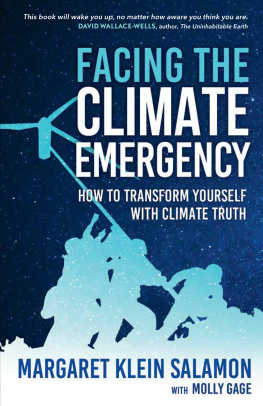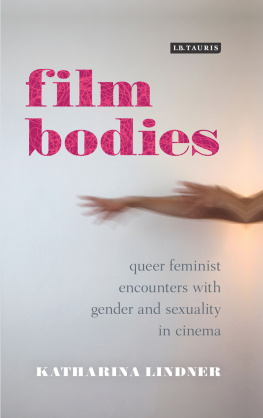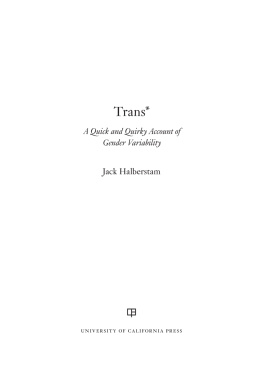Assuming a Body
ASSUMING A BODY
Transgender and Rhetorics of Materiality
Gayle Salamon

COLUMBIA UNIVERSITY PRESS
NEW YORK
Columbia University Press
Publishers Since 1893
New York Chichester, West Sussex
cup.columbia.edu
Copyright 2010 Columbia University Press
All rights reserved
E-ISBN 978-0-231-52170-3
Library of Congress Cataloging-in-Publication Data
Salamon, Gayle.
Assuming a body: transgender and rhetorics of materiality / Gayle Salamon.
p. cm.
Includes bibliographical references and index.
ISBN 978-0-231-14958-7 (cloth: alk. paper)
ISBN 978-0-231-14959-4 (pbk.: alk. paper)
ISBN 978-0-231-52170-3 (e-book)
1. TransgenderismPsychological aspects.
2. Transgender peoplePsychology.
3. Gender identity. 1. Title.
HQ77.9.S25 2010
306.768dc22 2009031454
A Columbia University Press E-book.
CUP would be pleased to hear about your reading experience with this e-book at .
References to Internet Web sites (URLs) were accurate at the time of writing. Neither the author nor Columbia University Press is responsible for Web sites that may have expired or changed since the book was prepared.
FOR JULIE
who helped me make it out and
who has always taught me about sameness and difference
CONTENTS
First and last thanks go to Judith Butler, whose inspiring work and unfailing support made this book possible.
Thanks to my editors Wendy Lochner and Susan Pensak at Columbia University Press, and to three anonymous reviewers, whose helpful suggestions strengthened this manuscript.
Thanks to Princeton University and my colleagues and friends there including: Eduardo Cadava, Zahid Chaudhary, Anne Cheng, Jim Clark, Isabelle Clark-Decs, Jill Dolan, Jeff Dolven, Diana Fuss, R. Marie Griffith, Daniel Heller-Roazen, Claudia Johnson, Meredith Martin, Deborah Nord, Jeff Nunokawa, Nigel Smith, Val Smith, Alexandra Vazquez, Stacy Wolf, and Michael Wood. Thanks also to the Society of Fellows at Princeton whose support gave me the time to complete much of this work: Leonard Barkan, the indefatigable Mary Harper, Carol Rigolot, Cass Garner, and Lin DeTittia, with particular thanks to fellow fellows Margot Canaday, Jen Rubenstein, Ben Kafka, Graham Jones, Miriam Petty, Mendi Obadike, Bianca Calabresi, and Martin Scherzinger. Thanks also to the Fund for Reunion and Debbie Bazarsky at the LGBT Center at Princeton.
Profound thanks to Alan Schrift and Johanna Meehan, without whose early and continued encouragement I would not have found this path. Thanks to James Kissane and Knut Tarnowski for meeting impatience with kindness and intellectual generosity.
I am deeply glad for the good company of Kaja Silverman, Joan Scott, David Kazanjian, Josie Saldana, Ken Corbett, David Eng, Teemu Ruskola, Zrinka Stahuljak and Laure Murat. Thank you to Gail Weiss, Ewa Ziarek, Angela McRobbie, Penny Deutscher, Ann Murphy, Samir Haddad, Mary Beth Mader, Diane Perpich, Kelly Oliver, Denise Riley, Petra Kuppers, Elizabeth Weed, Anne Fausto-Sterling, and Carol Armstrong. I have benefited from the wisdom of C. L. Cole, Jack Halberstam, Lisa C., Erik Schneider, Dylan Scholinski, and Patrick Letellier in conversations about trans issues.
Thanks go to friends and colleagues during my time at UC Berkeley: Homay King, Catherine Zimmer, Jill Stauffer, Beth Ferguson, Gillian Harkins, Katrin Pahl, James Salazar, Rob Miotke, Emma Bianchi, Felipe Gutterriez, Jane Taylorson, Maxine Fredericksen, and Carl Fredericksen.
Thanks to Judith Butler, Kaja Silverman, Sharon Marcus, and David Hoy for invaluable comments and advice on the project while still in the form of a dissertation. I am grateful for comments on the first chapter from Karl Britto, Michael Lucey, Charis Thompson, Paola Bacchetta, and Leigh Gilmore. Thanks to my students at Berkeley and at Princeton, with particular thanks to Cathy Hannabach.
For true friendship and sustaining kinship, I am grateful to Dustin Ray Jermier, Armon Kasmai, Miss A, Mike Nield, and Lila Thirkield. Thanks to the Lexington Club and to Sunny, Ace, Danny, Libby, Yvette, Kelly, Steph, Bre, and Kiki. I am grateful for the keen eyes of Ace Morgan, Lily Rodriguez, and Allison Wykoff.
For various forms of shelter while writing, thanks to Jane Huber and Gerry Kiwanuka, Patrick Letellier and Keith Hodge, Nello Carlini, Ben Kafka and Julie Coe, and Wendy Brown.
Thanks to Julie Salamon, Cheryl Clark, Richard Salamon, and Marilyn Ayers-Salamon.
Finally: gratitude beyond measure, in every register, to A. B. Huber. You are my magnetic north.
Chapter 1 appeared first as The Bodily Ego and the Contested Domain of the Material, in differences: A Journal of Feminist Cultural Studies 15, no. 3 (2004): 95122. Chapter 2 appeared first as The Sexual Schema: Transposition and Transgenderism in the Phenomenology of Perception in Laurie Schrage, ed., Youve Changed: Sex Change and Personal Identity (Oxford University Press, 2009). Chapter 3 appeared first as Boys of the Lex: Transgenderism and Rhetorics of Materiality in GLQ: A Journal of Lesbian and Gay Studies 12, no. 4 (September 2006): 575597. Parts of chapter 4 appeared first as Transfeminism and the Future of Womens Studies, in Joan Scott, ed., Womens Studies on the Edge (Duke University Press, 2008), and as Transmasculinity and Relation: Commentary on Griffin Hansburys Middle Men in Studies in Gender and Sexuality 6, no. 3 (2005): 265275.
Assuming a Body is a project that works questions of embodiment through phenomenology (primarily the work of Merleau-Ponty), psychoanalysis (the work of Freud and Paul Schilder), and queer theory in order to consider how each of these disciplines conceives of the body. I seek to challenge the notion that the materiality of the body is something to which we have unmediated access, something of which we can have epistemological certainty, and contend that such epistemological uncertainty can have great use, both ethically and politically, in the lives of the non-normatively gendered. Throughout, the book takes up recent theorizations of transgendered and transsexual bodies to suggest both that those theorizations might benefit from phenomenological and psychoanalytic understandings of the body and, perhaps more crucially, that our current ideas of what a body is will be irremediably diminished until trans bodies and subjectivities are considered in a more thorough way. The project thus wants to mark the specificity of trans bodies and subjectivities and also to resist the temptation to define that specificity in resolutely material terms. I am not arguing that the transgendered body has a material specificity that marks it as different from a normatively gendered body, but rather that the production of normative gender itself relies on a disjunction between the felt sense of the body and the bodys corporeal contours and that this disjunction need not be viewed as a pathological structure.
In this book I examine the relation between the material and phantasmatic in accounts of bodily being and hope to show that this need not be a relation of incompossibility, but can be characterized by a productive tension that accounts for ways in which the materiality of the body is present to consciousness as well as importantly, the ways it absents itself from consciousness. I read theories of embodiment offered by Maurice Merleau-Ponty, Sigmund Freud, Paul Schilder, and Judith Butler, questioning how the relation between the phantasmatic and the material contained within those theories might contribute to a better understanding of trans bodies. At the same time, I ask how a consideration of trans bodies might help us understand how relations between the phantasmatic and the material can be embodied and lived. Each of these inquiries opens up onto the broader question of what it means to be embodied. Throughout, I rely on the notion of the phantom or ambivalent presence to complicate suppositions about the nature of bodily being, where that phantom is sometimes textual and sometimes material, sometimes designating the ambivalent presence of a particular region or part of the body and sometimes indicating a characteristic of embodied subjectivity in general.
Next page









